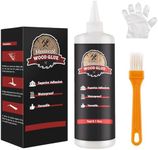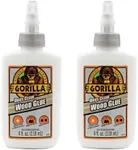Buying Guide for the Best Wood Glue For Furniture Repair
When it comes to repairing furniture, choosing the right wood glue is crucial for ensuring a strong and lasting bond. Wood glue is specifically designed to adhere to wood surfaces, making it ideal for furniture repair. To make an informed decision, you need to understand the key specifications and how they relate to your specific needs. Here are the main factors to consider when selecting wood glue for furniture repair.Type of Wood GlueWood glue comes in various types, including PVA (polyvinyl acetate), polyurethane, hide glue, and epoxy. PVA glue is the most common and is suitable for most indoor furniture repairs due to its ease of use and strong bond. Polyurethane glue is waterproof and ideal for outdoor furniture. Hide glue is traditional and reversible, making it great for antique furniture. Epoxy is extremely strong and good for filling gaps. Choose the type based on the specific requirements of your furniture repair project.
Bond StrengthBond strength refers to how well the glue holds the wood pieces together. This is important because a strong bond ensures the durability and longevity of the repair. Bond strength can vary from moderate to very strong. For heavy-duty repairs or furniture that will bear weight, opt for a glue with high bond strength. For lighter repairs, a moderate bond strength may suffice.
Drying TimeDrying time is the period it takes for the glue to set and reach its full strength. This can range from a few minutes to several hours. Fast-drying glues are convenient for quick repairs, but they may not allow enough time for adjustments. Longer drying times provide more flexibility during the repair process but require patience. Choose a drying time that fits your schedule and the complexity of the repair.
Water ResistanceWater resistance is crucial if the furniture will be exposed to moisture or used outdoors. Some wood glues are water-resistant or waterproof, ensuring the bond remains strong even in damp conditions. For indoor furniture, water resistance may not be as critical, but for outdoor furniture or pieces in humid environments, opt for a glue with high water resistance.
Ease of UseEase of use refers to how simple the glue is to apply and clean up. Some glues come with applicators that make precise application easier, while others may require additional tools. Consider how comfortable you are with the application process and whether you need a glue that is easy to clean up after use. For beginners, a user-friendly glue can make the repair process smoother.
Color and FinishThe color and finish of the glue can affect the appearance of the repaired furniture. Some glues dry clear, while others may have a yellowish tint. If the repair is in a visible area, you may want a glue that dries clear to maintain the aesthetic of the furniture. For hidden repairs, the color may be less important. Choose a glue that matches the finish of your furniture for the best visual result.



















